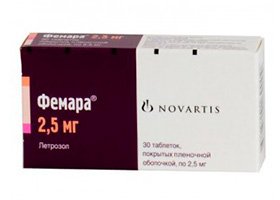
All iLive content is medically reviewed or fact checked to ensure as much factual accuracy as possible.
We have strict sourcing guidelines and only link to reputable media sites, academic research institutions and, whenever possible, medically peer reviewed studies. Note that the numbers in parentheses ([1], [2], etc.) are clickable links to these studies.
If you feel that any of our content is inaccurate, out-of-date, or otherwise questionable, please select it and press Ctrl + Enter.
Femara
Medical expert of the article
Last reviewed: 04.07.2025

Femara is an anticancer drug.
 [ 1 ]
[ 1 ]
ATC classification
Active ingredients
Pharmacological group
Pharmachologic effect
Indications Femara
It is used to treat the following disorders:
- breast cancer (in its widespread form) in postmenopausal women who have previously been treated with antiestrogens (such as tamoxifen);
- early stage breast cancer in postmenopausal women.
 [ 2 ]
[ 2 ]
Pharmacodynamics
The drug is non-steroidal and has an antitumor effect. Femara is a drug that specifically slows down the activity of the aromatase enzyme. By means of competitive synthesis with the aromatase enzyme subunit, which is involved in the processes of binding estrogens, it prevents the stimulating effect of the latter on tumor growth. It also independently helps suppress its growth.
During treatment of breast cancer in its widespread form (at the postmenopausal stage), daily intake of letrozole causes a decrease in the values of estrone sulfate, as well as estrone with estradiol in the blood (by 75-90%). At the same time, no changes in androstenedione values are observed. Thus, blockade of estrogen biosynthesis processes does not lead to accumulation of androgens, which are precursors of estrogens. In addition, no changes are observed in the level of lutropin and FSH, as well as in thyroid hormone values.
The medication does not affect the binding processes of steroid hormones located in the adrenal glands, which avoids the correction of GCS and mineralocorticosteroids.
Pharmacokinetics
Letrozole is rapidly absorbed from the gastrointestinal tract. Bioavailability is 99.9%. Food intake slightly reduces the degree of absorption. Synthesis with blood protein is 60%.
Equilibrium values are observed after 3-6 weeks if the drug is taken in a standard dose every day. The drug undergoes metabolic processes, during which an inactive compound is formed.
Excretion of the substance's metabolic products occurs through the intestines and kidneys. The half-life is 48 hours.
Use Femara during pregnancy
Femara should not be prescribed to pregnant women.
Contraindications
Main contraindications:
- breastfeeding period (if it is necessary to take medications, you should stop breastfeeding);
- the presence of intolerance to the elements of the drug;
- hormonal status that occurs in women in their reproductive period;
- children and adolescents under 18 years of age.
 [ 11 ]
[ 11 ]
Side effects Femara
The use of the drug usually causes side effects with a moderate degree of severity. They do not require discontinuation of the drug.
Negative reactions include: swelling, rashes, headaches, vomiting with nausea and a feeling of general weakness. In addition, hot flashes, pain in the back and arms and legs occur. Thinning of the hair, weight gain, vaginal bleeding and anorexia are also observed.
Interactions with other drugs
In case of combination with tamoxifen in a 20 mg dose, a decrease in the values of this drug by 38% is observed, while no reverse effect on tamoxifen values is noted. There is no information regarding the use of the drug together with other antitumor agents.
The probability of significant interaction of the drug with the isoenzyme CYP2C19 is quite low. However, it should be used with caution in combination with drugs that are metabolized by hemoprotein isoenzymes.
Storage conditions
Femara should be kept at temperatures no higher than 30 ° C.
 [ 17 ]
[ 17 ]
Analogues
Analogues of the drug are Letrotera, Letrozole with Letrozole-Teva, as well as Extraza and Letroza.
Reviews
Femara is a non-steroidal aromatase inhibitor (3rd generation) that is known to reduce estrogen levels by 98%, which are formed from androgens in postmenopausal women with the help of the aromatase enzyme. Femara is considered the most effective of the drugs in this group.
When used in early adjuvant therapy, this drug is more effective than Tamoxifen (when comparing the frequency of relapses and time periods before metastases). The drug is considered very effective and safe (especially for women who have a high risk of relapse (if there are metastases in the lymph nodes or if the woman has previously undergone chemotherapy)). Sometimes, the use of the drug allows avoiding radiation and cytostatic therapy, as well as surgery.
Reviews show that this drug is better tolerated than Tamoxifen. The therapy lasted for 4.5-6 years and only some patients developed side effects: myalgia, hot flashes, and arthritis. In addition, anorexia, peripheral edema, nausea, and severe fatigue were observed.
Patients also report that taking aromatase inhibitors often causes osteoporosis and increases the risk of fractures. For this reason, combination therapy includes drugs such as Zometa, which is a biophosphonate.
 [ 20 ]
[ 20 ]
Manufacturer
Attention!
To simplify the perception of information, this instruction for use of the drug "Femara" translated and presented in a special form on the basis of the official instructions for medical use of the drug. Before use read the annotation that came directly to medicines.
Description provided for informational purposes and is not a guide to self-healing. The need for this drug, the purpose of the treatment regimen, methods and dose of the drug is determined solely by the attending physician. Self-medication is dangerous for your health.

